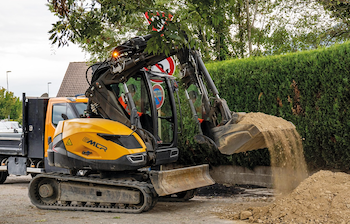Do more with less
Replace multiple machines with a single, innovative solution.
 |
| From a single position, a crawler skid excavator can dig then swing up and dump into a truck — all within an incredibly compact 9-foot (2.7-meter) radius. |
by Peter Bigwood
Construction, building, landscape — regardless of the industry, contractors can agree on one thing; doing more with less is important for maximizing efficiency and profits. This is especially true for larger expenditures like equipment and labor. For example, what would happen to an operation’s bottom line if it could replace a mini excavator, compact track loader (CTL) and telehandler with a single machine?
The idea is good in theory, right? Everyone who has had to rely on a multi-tool is well-aware these devices rarely deliver high-quality results across functions. They usually offer passable performance on many things, but are far from spectacular at any of them. Every once in a while, though, a truly game-changing solution comes along.
With the introduction of crawler skid excavators to the market, contractors can harness the speed and agility of a CTL, the maneuverability and digging capabilities of a mini excavator and the reach of a telehandler all in a single machine. Here are the key features of crawler skid excavators that provide the mobility, versatility and speed to get the job done with limited equipment and crew requirements.
Boom design
Boom design is key to optimal versatility. The mono-boom design is very common and provides ample power for digging and other applications, but has limited range of motion due to its rigid nature. When space is at a premium, contractors would be better served with a side-mounted, two-piece boom that offers greater compactness and mobility. This design features an articulated arm with a total of five joints, including one between the second and third sections, that allows for limited side-to-side motion. Bending or straightening each joint in sequence results in a boom that can extend almost straight in any direction or fold back in on itself for maximum compactness.
What does this look like in practice? Say a mono-boom excavator and a similar-sized crawler skid excavator with a side-mounted, two-piece boom are both tasked with digging a trench. Both machines start their trench at a similar distance. However, as the bucket works back toward the machine, the mono-boom excavator must stop and reposition while the crawler skid excavator is able to continue digging — until the bucket is under the machine if necessary. By working from a single position, contractors save time and effort.
The crawler skid excavator’s two-piece boom also needs less space to operate, opening up the use of powerful machines even in tight spaces and limiting the need for large work crews with handheld equipment or fleets of small equipment. Working against the blade with a mono boom excavator, for example, requires laying the main part of the boom almost straight out with the dipper stick and bucket folded under. This position nearly doubles the overall length of the machine and requires a lot of clearance around the excavator for working or swinging. With a side-mounted, two-part boom, on the other hand, the bucket can be positioned directly in front of the blade or along the tracks for a compact 360-degree footprint that is only slightly wider than the body of the machine.
Attachments for better versatility
The crawler skid excavator’s innovative boom design provides increased power and range of motion compared to other excavators, but that’s only the first part of the equation. A variety of tools for applications from material handling to trenching for utility lines, demolition to forestry work allow operators to truly capitalize on the equipment’s versatility.
By angling the first part of the boom back along the cab, operators create a compact profile that maximizes lifting power and increases overall stability, resulting in a machine that, pound for pound, vastly outperforms similar-sized excavators. This design allows for the use of larger skid steer buckets — up to .98 cubic yards (.75 cubic meters) — and enables the crawler skid excavator to operate as a CTL or skid steer as well as an excavator. The boom design also allows for the loader bucket to be braced against the blade for applications such as grading and ground leveling. This innovative feature stabilizes the bucket, distributing the forces to the frame of the crawler skid excavator and reducing stress on the boom, prolonging component life.
Operators can find more versatility by switching out a crawler skid excavator’s bucket attachment for a set of forks to essentially become a highly maneuverable material handler. Unlike mono-boom excavators, the two-part boom provides a greater range of motion while maintaining level forks when retrieving pipe, stone or other materials and quickly and safely transporting them to the area where workers need them. With this ability, there’s no need for wheelbarrow brigades, manually loading or unloading pallets or other time and labor intensive methods.
Revolutionize your job site
So, what’s the bottom line? Simply this, crawler skid excavators not only have the potential to reduce the need for multiple machines on-site — whether that’s excavators, telehandlers, backhoes or CTLs — they also provide an opportunity to revolutionize the jobsite.
Products that claim to replace X, Y and Z rarely live up to expectations. However, those products in the hands of innovative engineers laser-focused on improving the method — not just the machine — can lead to true ingenuity and game-changing productivity.
Peter Bigwood is the general manager for Mecalac North America.








